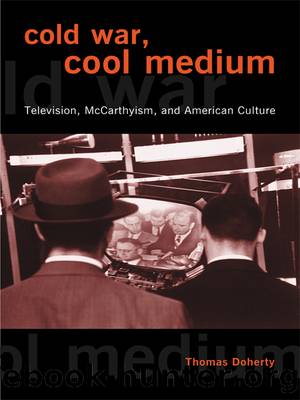Cold War, Cool Medium by Thomas Doherty

Author:Thomas Doherty
Language: eng
Format: epub
Tags: Social Science/Popular Culture
Publisher: Columbia University Press
Published: 2011-11-17T16:00:00+00:00
Controlled schizophrenia: Richard Carlson (right) strikes a worried pose as triple-agent Herbert A. Philbrick in Ziv’s syndicated series I Led 3 Lives (1953–1956). (Courtesy Photofest)
Religious Broadcasting
In 1953, President Eisenhower advised Americans to turn to religion, pretty much the way they rooted for a hometown baseball team or mowed the lawn, as a useful habit to harden the glue of civic comity. “Whatever our individual church, whatever our personal creed, our common faith in God is a common bond among us,” proclaimed Ike. “In our fundamental faith we are all one.” Throughout the popular culture and political rhetoric of Cold War America, religion stood as a sturdy pillar in the anticommunist fortress sustaining one nation, “under God,” a phrase added to the Pledge of Allegiance in 1954. Communism was godless, America was godly.
Rather than sparking a revival of born-again piety, however, the God-mongering made America less not more religious. For all the professions of faith, the faith itself was hazy and lackadaisical, undemanding and undistinguished, leavening out the devotional demands of different dogmas and creeds. Extremism in denunciation of communism may not have been a vice, but in matters of religion an undue insistence on the inerrantism of a particular doctrine was considered bad form. Increasingly, politicians referred to America not as a Christian nation but as a Judeo-Christian nation: a modifier that once meant eternal damnation now became a required prefix. Little wonder that to nonbelievers the sectarian divides in American Protestantism and Judaism came to seem more a matter of social class and housing patterns than doctrinal differences. In television’s I Led 3 Lives, when a lifelong member of the Communist Party makes a deathbed conversion, he advises double agent Herbert A. Philbrick to turn away from communism and toward religion. “The denomination doesn’t matter,” he mutters, taking the Eisenhower line on theology.
Predictably, the consensus medium of television professed a consensus view of religion. Though the flood of programming tied to Christmas and Easter assumed a normative Christianity in the Nielsen congregation, the pageants were never very precise in theology or ceremony. The Jewish comedian on The George Burns and Gracie Allen Show and the Polish Catholic on The Liberace Show celebrated the holiday with the same fervent devotion to decorating the tree and gifting the kids.
Of course, for a more committed priesthood, the missionary work facilitated by broadcasting was a match made in heaven. From the earliest days of commercial radio in the 1920s, when Aimee Semple McPherson and Billy Sunday spewed fire and brimstone from the airwaves and spurred a great awakening in collection-plate profits, enterprising preachers had exploited the means of mass communications to further the work of God or, more often, man. But where radio had been a pulpit, an extension of preaching and proselytizing, television would be an altar, a site for low-definition ritual devotion.
The aura of television itself seemed to invite meditations on the mystical union of broadcasting and divinity. Invested with more celestial majesty than the typeset words of the commonplace Bible,
Download
This site does not store any files on its server. We only index and link to content provided by other sites. Please contact the content providers to delete copyright contents if any and email us, we'll remove relevant links or contents immediately.
| Africa | Americas |
| Arctic & Antarctica | Asia |
| Australia & Oceania | Europe |
| Middle East | Russia |
| United States | World |
| Ancient Civilizations | Military |
| Historical Study & Educational Resources |
Magic and Divination in Early Islam by Emilie Savage-Smith;(1500)
Ambition and Desire: The Dangerous Life of Josephine Bonaparte by Kate Williams(1344)
Bohemians, Bootleggers, Flappers, and Swells: The Best of Early Vanity Fair by Bohemians Bootleggers Flappers & Swells- The Best of Early Vanity Fair (epub)(1343)
Papillon by Henry Charrière(1310)
Twelve Caesars by Mary Beard(1256)
Operation Vengeance: The Astonishing Aerial Ambush That Changed World War II by Dan Hampton(1136)
What Really Happened: The Death of Hitler by Robert J. Hutchinson(1129)
London in the Twentieth Century by Jerry White(1113)
Time of the Magicians by Wolfram Eilenberger(1089)
The Japanese by Christopher Harding(1086)
Twilight of the Gods by Ian W. Toll(1084)
Lenin: A Biography by Robert Service(1045)
The Devil You Know by Charles M. Blow(985)
A Social History of the Media by Peter Burke & Peter Burke(936)
Freemasons for Dummies by Hodapp Christopher;(922)
Napolean Hill Collection by Napoleon Hill(902)
Henry III by David Carpenter;(891)
The Churchill Complex by Ian Buruma(881)
The Rise and Triumph of the Modern Self by Unknown(879)
